Diamonds have long been associated with luxury, elegance, and everlasting love. However, with the rise of lab-created diamonds, the industry is undergoing a significant shift. Lab diamonds are becoming increasingly popular, offering a sustainable and affordable alternative to natural ones.
So, how do they go from the lab to your fingers? Let’s take a closer look.
The process of creating lab diamonds starts with a small diamond seed, which is placed inside a growth chamber. The growth chamber is then filled with a mixture of gasses, including hydrogen and methane, and heated to extremely high temperatures. Under these conditions, the carbon atoms in the gasses begin to bond and form a crystal lattice structure around the seed, gradually growing into a rough diamond.
Once the rough diamond has been grown, it is then cut and polished just like a natural one. The end result is a lab-created diamond that is virtually indistinguishable from a natural one to the naked eye.

One of the main advantages of these diamonds is their environmental impact. Traditional mining can have a devastating impact on the environment, including deforestation, soil erosion, and water pollution. In contrast, lab diamonds have a much smaller carbon footprint, as they require significantly less energy and produce fewer greenhouse gas emissions.
Another advantage is their affordability. Natural diamonds are rare and expensive, with prices driven up by a complex supply chain and marketing campaigns. Lab ones, on the other hand, are produced in a controlled environment and can be sold at a fraction of the cost of natural ones. This means that consumers can enjoy the beauty and quality of it without breaking the bank. Lab diamonds UK are becoming increasingly popular, with many retailers offering a wide range of lab-created options in various sizes, shapes, and colors.
But how do they compare to natural diamonds in terms of quality and durability?
In terms of physical and chemical properties, they are identical to natural ones. This means that they have the same hardness, density, and refractive index as natural diamonds. In fact, they are often of higher quality than natural ones, as they are grown under controlled conditions and are free from the imperfections and impurities that can be found in natural ones.
They are also durable and long-lasting, just like natural ones. They can be used in all types of jewelry, from engagement rings to earrings and necklaces, and can be passed down from generation to generation as a family heirloom.

The popularity of lab diamonds is on the rise, and for good reason. Consumers are becoming more environmentally conscious and are looking for sustainable alternatives to traditional mining. They are also seeking affordable options without compromising on quality and beauty.
So, if you’re considering purchasing a lab-created diamond, it’s important to do your research and buy from a reputable retailer. Look for a retailer that specializes in lab diamonds and has a good reputation in the industry.



